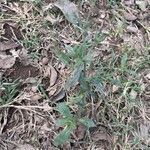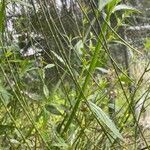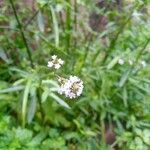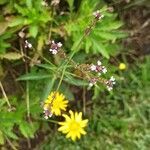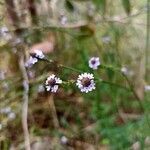Short-lived perennial; stems square, somewhat scabrid, to c. 1 m tall. Lvs mostly petiolate, the uppermost sometimes subsessile. Lamina of lower lvs to c. 10 × 2.5 cm, lanceolate to oblong or rhomboid, with ± strigulose hairs scarcely swollen at base above and below, usually coarsely or deeply serrate; veins not impressed above; base attenuate; apex acute. Infl. loosely paniculate; spikes to c. 5 cm long at maximum flowering, hairy, elongating to c. 15 cm long at fruiting, slender; fls rather dense but soon becoming distant. Bracts ± = calyx at flowering, lanceolate, keeled, acuminate, ciliate. Calyx 2-3 mm long, glandular-hairy; teeth green, acute. Corolla tube > calyx, rather sparingly hairy outside; limb 2-3 mm diam., bluish or mauve, drying a similar colour. Nutlets c. 1.5 mm long, oblong, faintly ribbed dorsally, brown, finely white-papillate on flattened ventral surface.
Perennial herb or shrub, 1-2 m high; stem erect or suberect, branched above, 4-angled, with whitish angles and flat faces. Leaves ovate, rhombic-ovate, spathulate or oblanceolate, 20-50 x 10-20 mm, apex acute, base tapering into narrow petiole, margins serrate to double serrate, teeth sometimes obtuse; both surfaces scabrid with sparse, short-appressed, antrorse, tubercle-based hairs, bristles more numerous on lower surface. Inflorescences much branched, with several to many corymbose-paniculately arranged spikes; spikes slender or filiform; bracts lanceolate. Flowers lavender or lilac to violet or violet-blue. Calyx hirsute, hispidulous or tomentose. Corolla: tube exserted from calyx; limb inconspicuous, with subequal, obtuse lobes. Fruit dry, enclosed in calyx, separating at maturity into four 1-seeded, crustaceous nutlets.
Herb 0.3–1 m high; branches erect, quadrangular, smooth, sparsely hairy (eglandular). Leaves shortly petiolate or sessile; lower leaves variously acutely serrate, 1-or 2-pinnatifid, 2–7 cm long, 0.5–3 cm wide; upper leaves incised to subentire, smaller than lower leaves, usually ±narrowly ovate; base ±acute; apex acute (for both upper and lower leaves). Inflorescence a lax terminal panicle with long branches ending in a spike; bracts at least reaching top of calyx, with peduncle, bracts and calyx strongly glandular. Calyx 5-toothed, 2.5–3 mm long. Corolla pale pink or lilac, slightly longer than calyx; tube c. 2.5 mm long. Mericarps 1.5–2 mm long.
Perennial herb or shrub, up to 2 m high. Stems erect or suberect; 4-angled. Leaves simple, petiolate or sessile, not amplexicaule; blade ovate, rhombic ovate or narrowly obovate, 20-50 x 10-20 mm, margins serrate to double serrate, base attenuate. Flowers: in much-branched inflorescences with lax groups of triads; triads with median spike usually longer and subsessile, lateral ones on peduncles, 5-8 mm long; calyx 2-3 mm long; corolla 3.0-3.5 mm long; corolla violet or purple; Nov.-May.
Herb, up to 0.8 m high. Leaves petiolate or tapering to cuneate-attenuate base, 30-100 mm long, lanceolate or oblong-lanceolate, scabrid. Inflorescence 750 mm long, dense at apex, more open below and finely strigillose. Flowers purple.
A herb. It keeps growing from year to year. The leaves are 5-12 cm long by 1-3 cm wide.
